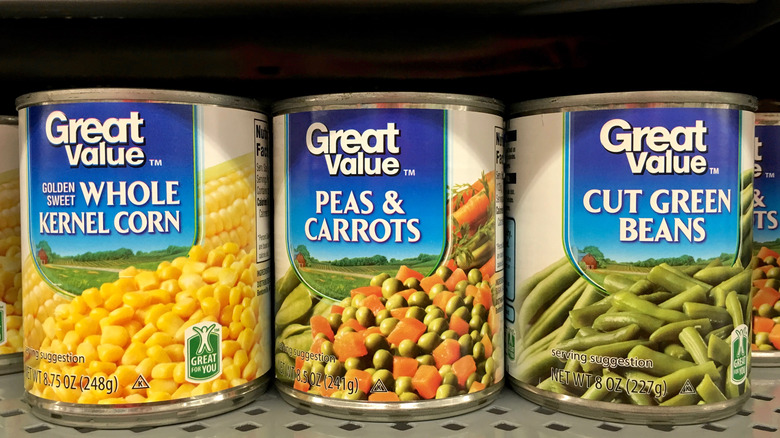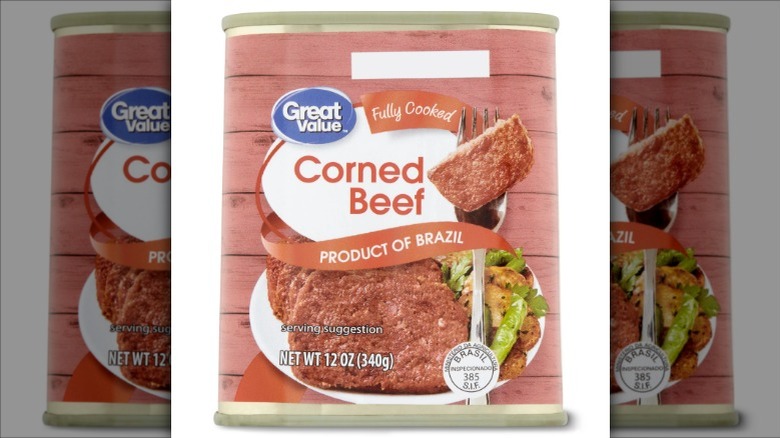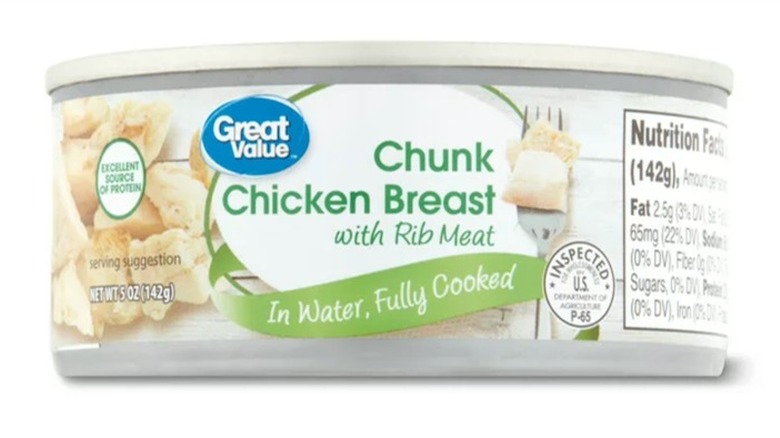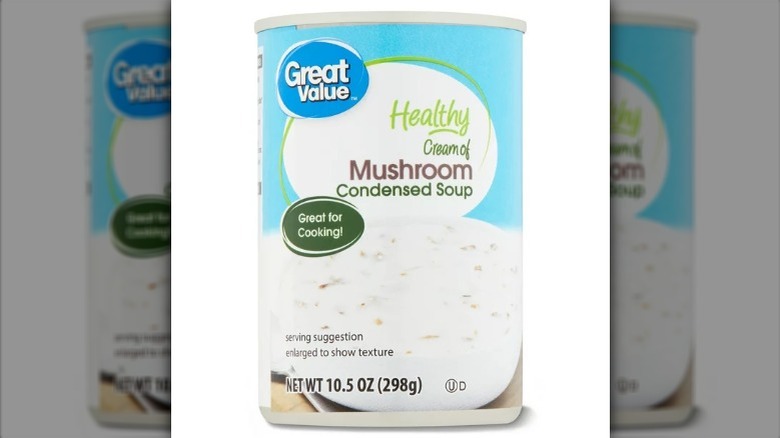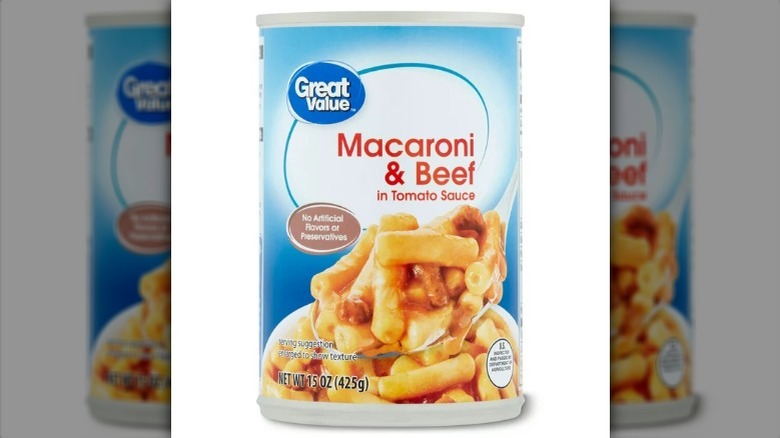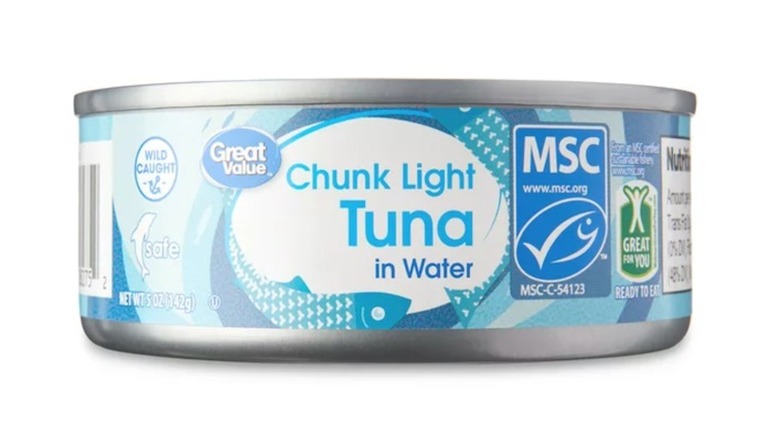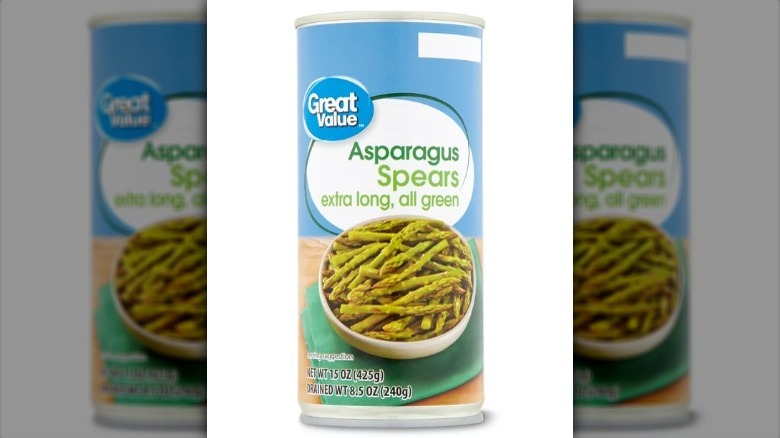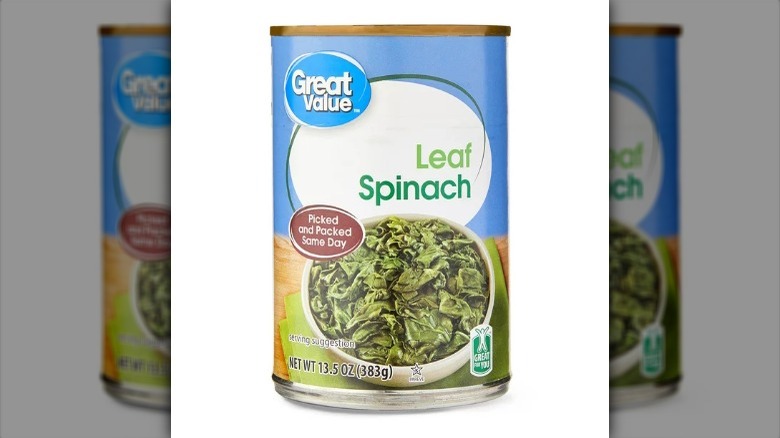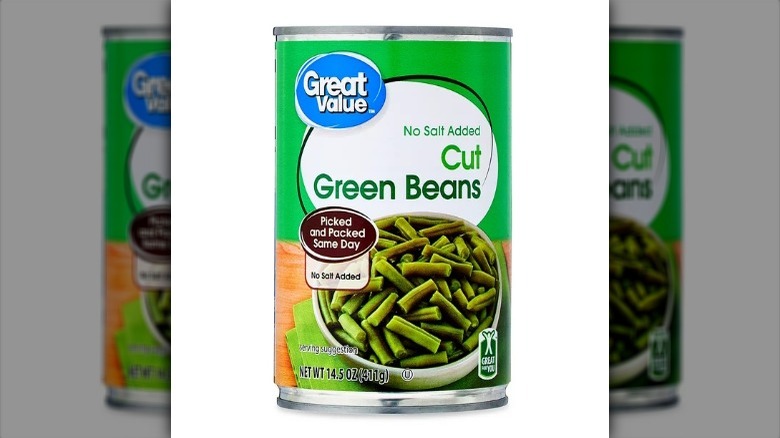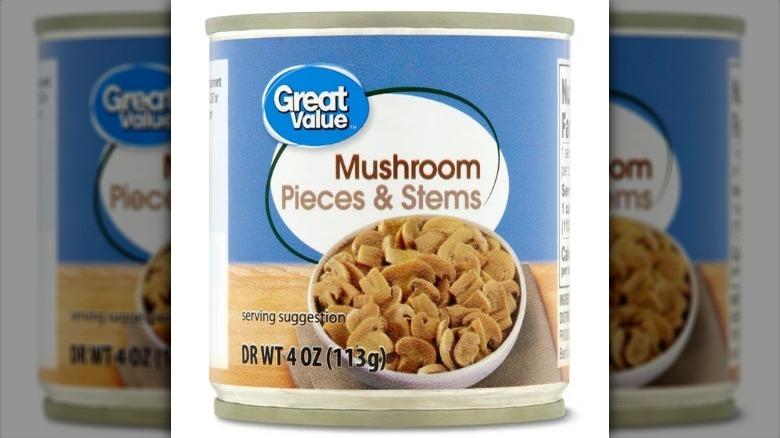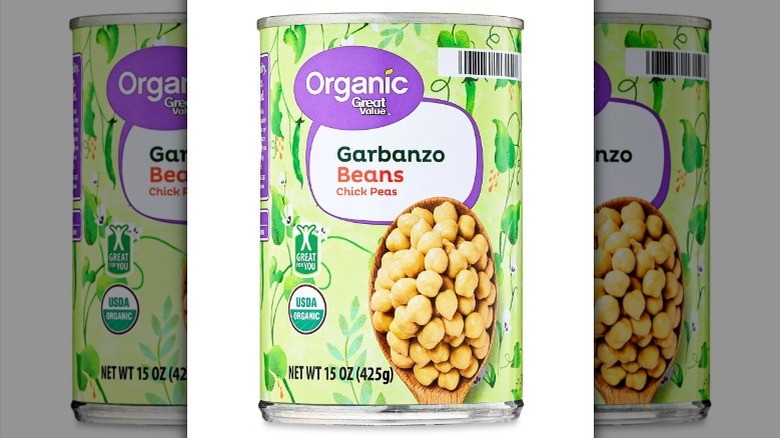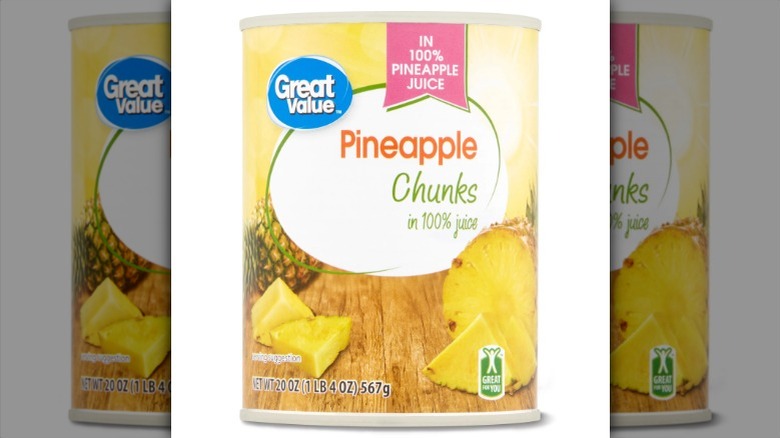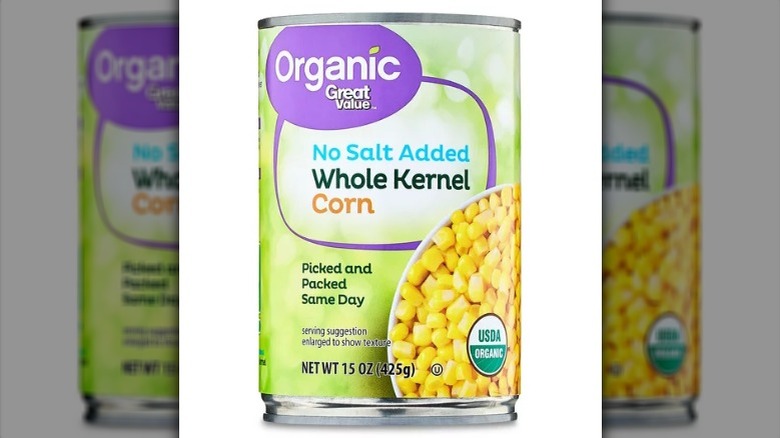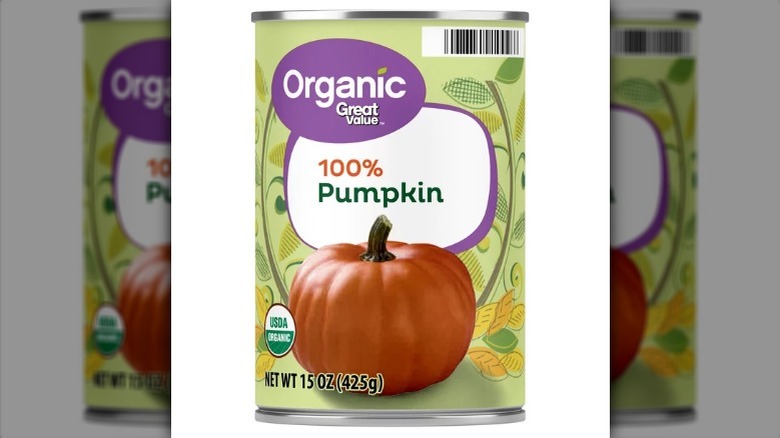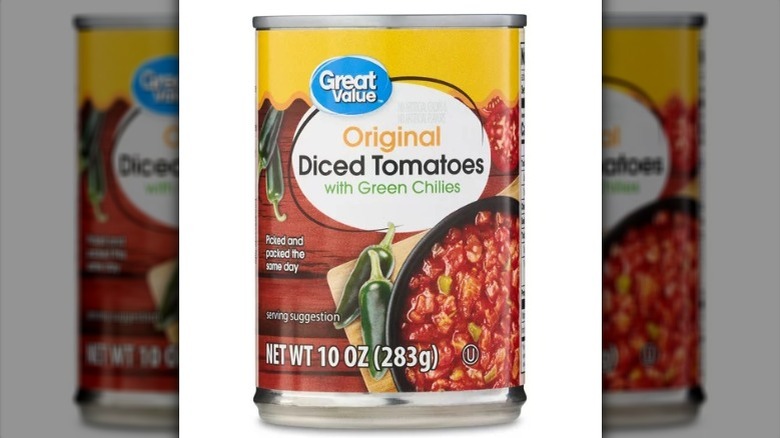Ranking 14 Great Value Canned Foods From Worst To Best
We may receive a commission on purchases made from links.
Virtually every grocery store chain has developed a unique brand of its own under which it sells discounted products, and Walmart is no different. It introduced its Great Value brand back in 1993, with the singular focus of offering the highest-quality products at the most unbeatable prices (via Walmart). All of its Great Value products undergo rigorous research and development to ensure that they are as good as, if not better than, their brand-name counterparts. It has a dedicated Quality Monitoring Program that is intended to continuously assess the caliber of its products through customer feedback.
What may surprise some consumers is that many of its thousands of products under the Great Value label are manufactured by the same companies who manufacture the brand-name versions of these products, per NCESC.com. Companies like Sara Lee, Ziploc, Kellogg's, and Kraft all produce Great Value-brand products, which may seem like a conflict of interest, but it isn't. Walmart is one of the world's largest retailers, with huge buying power, which means it commands a vast percentage of valuable real estate in terms of shelf space. The audience this reaches represents a huge money-making opportunity that brand names can't capture on their own.
With all of this in mind, we wanted to take a look at some of the best and worst canned Great Value products you can buy. These items are ranked from worst to best not only by quality but by nutritional value, customer reviews, and personal experience.
14. Great Value Corned Beef
Ranking at the bottom of our list is Great Value Corned Beef. Canned corned beef has long been used as a staple in military food rations, thanks to its long shelf life, transportability, and the fact that it can be eaten straight from the can without cooking it. For non-military populations, the meat is an affordable alternative to fresh meat during times of famine, civil unrest, or natural disasters.
However, there are some serious considerations to be made before diving into a can of corned beef. First, much of the corned beef produced today comes from South America, and in particular Brazil, where its production has been linked to the devastating deforestation of the Amazon (via EarthSight). Additionally, canned corned beef is extraordinarily high in sodium. The Great Value brand contains a whopping 830 milligrams per 3-ounce serving, which is more than a third of the recommended daily allowance of sodium, per the FDA.
Lastly, there is no way to know exactly what cuts of beef have been used in producing canned corned beef. According to the United States' Code of Federal Regulations, beef products may contain virtually any part of the body, with the exception of the brain and organ meats of the cow (via My Fearless Kitchen). If you value sustainability, health, and knowing exactly what is in your food, we recommend skipping the canned corned beef.
13. Great Value Chunk Chicken Breast in Water
Great Value Chunk Chicken Breast in Water is ranked second to last on our list of Great Value items to consume, although it's not entirely a bad option. Canned chicken can be a great alternative to fresh chicken, particularly in recipes that call for cooked chicken, like a chicken salad. It is a quick source of lean protein, has a long shelf life, is affordable, and is convenient for those who are squeamish about handling raw chicken.
However, there are some downsides to canned chicken. Most canned chicken uses meat obtained from a factory farm. Factory farms are notorious for raising animals under inhumane, overcrowded conditions and using antibiotics. Additionally, like other canned meats, canned chicken is very high in sodium, which is added to increase its shelf life. The Great Value brand has 660 milligrams per 5-ounce serving, which is almost a third of the recommended daily allowance, per the FDA. And ultimately, the flavor and texture of canned chicken just doesn't stand up to the real deal.
The bottom line: Having a can of chicken on hand for an emergency isn't a bad idea, but if you're looking for quality and concerned about animal welfare, we'd skip it. It is extremely simple and cost effective to roast a whole chicken, and you can either freeze or can the cooked meat yourself, knowing exactly where the meat came from and what you put on it.
12. Great Value Healthy Cream of Mushroom Condensed Soup
We are no strangers to the ubiquitous presence of canned cream of mushroom soup in a myriad of recipes, from sauces for meat to a classic Thanksgiving favorite, the green bean casserole. While it certainly makes for a quick and easy dish, there are some pitfalls to this ingredient, which is why Great Value Healthy Cream of Mushroom Condensed Soup landed where it is on our list. Canned soups in general are considered a dubious purchase because of their high sodium content. Indeed, the Great Value version packs a whopping 410 milligrams of sodium per ½-cup serving. And let's be honest, who eats just ½ cup of soup in one sitting?
Also, while the word "cream" is listed in the title, there isn't all that much dairy in the soup, making it severely lacking in the flavor department. Then there's the issue with its texture, which is a bit like Elmer's glue. That being said, we aren't opposed to using it once or twice a year if you really want to capture the flavors of childhood. Alternatively, you could try making your own cream of mushroom soup, which is relatively simple and will yield infinitely better results.
11. Great Value Macaroni & Beef in Tomato Sauce
According to nutritionists, canned pasta is one of the worst canned foods you can buy, strictly from the standpoint of health (via CNET). They are generally loaded with sodium, high in sugar, and contain substantial quantities of additives, which is why we put Great Value Macaroni & Beef in Tomato Sauce towards the bottom of our list. Additionally, the meats often used in these types of canned pasta dishes are of questionable origin and quality. And let's face it, the taste and texture leave a lot to be desired.
That being said, a can of Great Value Macaroni & Beef in Tomato Sauce is incredibly inexpensive. You'd be hard pressed to make a homemade version of it at a competitive price unless you were making a really large batch. Additionally, some days you simply need a quick meal to feed the kids when you get home after a long day at work. So for that, we think this is a suitable option to have on hand for a rare treat.
10. Great Value Chunk Light Tuna in Water
Great Value Chunk Light Tuna in Water is our top-ranked canned meat product for a variety of reasons. Beyond its long shelf life and affordability, it's hard to mess up canned tuna, regardless of the brand. In fact, this product has a solid ranking of 4.5 out of 5 stars with over 1,800 reviews. Some reviewers have even insisted that the Great Value brand is better than the brand-name StarKist, which is high praise indeed.
According to Healthline, canned tuna is also a nutritional powerhouse, particularly if you opt for tuna that is canned in water versus oil. Tuna canned in water is high in protein, low in calories, loaded with omega-3 fatty acids, and replete with a number of essential vitamins and minerals, including vitamin D and selenium. And despite the intense processing that most canned meats undergo, Great Value's canned tuna is very minimally processed, containing only three ingredients: light tuna, water, and vegetable broth.
All that being said, there are two factors to consider prior to purchasing canned tuna — mercury content and sustainability. Tuna can be high in mercury, which is potentially toxic to children and women who are pregnant or breastfeeding. In terms of sustainability, tuna is notoriously overfished, which can be a problem in terms of disrupting the delicate oceanic ecosystem. Fortunately, Great Value does have the Marine Stewardship Council (MSC) stamp of approval on the can, indicating that it is a more sustainable option.
9. Great Value Asparagus Spears
Canned vegetables in general are a great staple to have stocked in your pantry. Besides the obvious benefits of having vegetables on hand when they would otherwise be out of season or spoil too rapidly, canned vegetables can be a great source of fiber, vitamins, and minerals (via Healthline). That being said, some vegetables suffer greatly in terms of texture and flavor during the canning process, and of these, asparagus is probably the worst. It not only becomes mushy; it becomes somewhat stringy, which is rather unappealing. For this reason, we placed Great Value Asparagus Spears in the middle of our list, but at the bottom of our canned vegetable choices.
Texture aside, canned asparagus is still better than no asparagus. According to Healthline, asparagus is a particularly rich source of antioxidants, insoluble fiber, folate, and potassium, making it a highly nutrient-dense vegetable. To combat the textural issues associated with canned asparagus, we recommend using it in soups or stews, where it is surrounded by other vegetables and can absorb some flavor from a rich broth and spices. Just be sure to drain it well before using to eliminate some of the sodium contained in the canning liquid.
8. Great Value Canned Leaf Spinach
We all know that green leafy vegetables are an important part of a healthy diet, and spinach is no exception. In fact, WebMD notes that spinach is high in potassium, lutein, vitamin K, vitamin A, iron, folate, and fiber. However, fresh spinach has a notoriously short shelf life, and if you've ever cooked with it, it's astonishing how much spinach it takes to create just a single serving once it cooks down, making it not particularly cost effective. The solution to this is canned spinach, and in particular Great Value Canned Leaf Spinach. In fact, not only is canned spinach a money-saving option, but it has been shown to have an extremely high content of immunity-boosting vitamin C (via Time).
There is one downside to canned spinach compared with freshly sautéed spinach, and that is its color and texture. Once canned, it develops an almost grayish hue that isn't particularly appetizing. It also has a mushy texture, virtually disintegrating in your mouth as you eat it. That being said, it can effectively be incorporated into soups, stews, lasagna, and egg dishes like a classic quiche Florentine. Just be sure to drain it well before use.
7. Great Value No Salt Added Cut Green Beans
Next on our ranking of Great Value canned foods is Great Value No Salt Added Cut Green Beans. Right off the bat, we want to point out that because there is no salt added to these green beans, they are a great canned vegetable to keep on hand if you are watching your sodium intake. That being said, when comparing nutritional value side by side with fresh green beans, fresh always wins, although they are remarkably comparable nutritionally across the board (via Prevention). The only exception to this was in the vitamin K department, where canned accounts for 49% of the recommended daily allowance (RDA) in contrast with fresh, which only accounts for 18% RDA.
We do want to note that in reading the reviews of these green beans, both the helpful positive and helpful negative reviews noted that there were foreign objects (stems and something that looked like a raisin) in the can alongside the green beans. This may or may not be a deal breaker, although we do recommend straining and double-checking the contents of the can prior to using the beans in a recipe.
Also, like with some of the other canned vegetables we have reviewed, there is a noticeable difference in texture between freshly cooked versus canned green beans. However, in a pinch, or when fresh green beans aren't in season, canned will suffice just fine, particularly in that Thanksgiving green bean casserole.
6. Great Value Mushrooms Pieces & Stems
When it comes to mushrooms, fresh is always best. But sometimes finding fresh mushrooms is a challenge, particularly in rural areas or in areas known as food deserts. For this reason, we are including Great Value Mushrooms Pieces & Stems on our list as a great option for use in soups, sauces, or even atop a pizza. Their texture is a bit on the chewy side, but their flavor is great. And mushrooms are incredibly good for you.
As WebMD notes, like fresh mushrooms, canned mushrooms are particularly rich in nutrients like phosphorus, riboflavin, niacin, and potassium. They are also full of protein and fiber, making them ideal as a meat alternative for those who are vegetarian or vegan. The only downside to canned mushrooms is their sodium content, which can be fairly high. To mitigate this, it is recommended that you drain and rinse your canned mushrooms thoroughly prior to use.
5. Great Value Organic Chick Pea Garbanzo Beans
If you don't already have your pantry loaded up with canned beans, you really need to go out and buy some. They are one of the greatest canned food items to keep on hand thanks to their affordability, long shelf life, practicality, and nutritional value. One of our personal favorites happens to be the chickpea, or garbanzo bean. For this reason, we ranked Great Value Organic Chick Pea Garbanzo Beans fairly high on our list, although we cannot quite figure out why they are spelled "chick peas" as opposed to "chickpeas."
Chickpeas are a remarkable source of potassium and fiber, both of which are retained in the canned version, although some other nutrients do suffer from the canning process. And while canned chickpeas can be high in sodium, when drained and rinsed, the sodium content in the beans is reduced by almost a third.
One word of caution that we've observed with Great Value beans in general, and their chickpeas in particular: They often will have other beans, like pinto or red kidney beans, mixed into the can. It is typically only a couple, but from a quality-control standpoint, we found that to be a bit frustrating.
4. Great Value Canned Pineapple Chunks
According to Everyday Health, not only is pineapple a nutritional powerhouse, but it has long been utilized by ancient cultures as a kind of folk remedy for a myriad of ailments. Pineapple is loaded with vitamin C, the anti-inflammatory bromelain, manganese, and antioxidants and even has antiviral properties. And the best part is that canned pineapple can be just as high in these nutrients as fresh pineapple, and in some cases higher (via Livestrong). For this reason, we think everyone should keep a can of Great Value Canned Pineapple Chunks in their pantry.
Not only is canned pineapple far more convenient than fresh pineapple, which is kind of a pain to hack into, but it's infinitely more cost effective, per Livestrong. On average, canned fruit costs one fifth the amount that fresh produce does. The canned version is also a great alternative if you don't think you can consume an entire pineapple before it spoils. The only word of caution with canned fruit in general is to avoid fruit that is packed in syrup, which is very high in sugar. It is best to opt for fruit that is canned in its own juice or in water. Great Value canned pineapple fits this bill.
3. Great Value Organic Whole Kernel Corn, No Salt Added
Fresh-grilled corn on the cob is one of the highlights of summer. But let's be honest, corn can be a huge pain to deal with. Cleaning off the husks and those pesky little hairy corn silks can be messy. For a quicker and equally nutritious option, we recommend Great Value Organic Whole Kernel Corn, No Salt Added. Cup for cup, canned corn is infinitely cheaper than fresh corn, and it retains a surprisingly delicious taste and texture. And unlike other brands, this one is a low-sodium alternative, making it a great option for those concerned with monitoring their sodium intake.
There are additional benefits to canned corn versus fresh corn, per Livestrong. Corn is one of the few foods that contains nearly all the B vitamins, and because B vitamins are water soluble, eating the canned version of corn may actually increase the body's ability to utilize these important vitamins. It is also loaded with antioxidants, magnesium, potassium, phosphorus, copper, iron, zinc, and the eye-friendly phytochemicals lutein and zeaxanthin. Whether you use canned corn in a salad or side dish or to create a delectable corn chowder, it is definitely one canned item you should add to your pantry.
2. Great Value Organic 100% Canned Pumpkin
If you have ever attempted to obtain the meat of a pumpkin by roasting it fresh, you will quickly recognize that canned pumpkin is a necessity, and Great Value Organic 100% Canned Pumpkin is a marvelous option. Chefs and nutritionists alike rank canned pumpkin as one of the best canned food items to buy, citing its consistency, convenience, affordability, and high nutritional content. Pumpkin is loaded with nutrients like beta-carotene, vitamin K, and powerful antioxidants. Additionally, it can be used as a replacement for dairy and oil in baked goods for those with dairy intolerances or who might be watching their fat intake.
Other uses for canned pumpkin include creating a skin-nourishing face mask when it is combined with an equal amount of Greek yogurt, and it is a great digestive aid when added as a supplement to dog food. The one thing to look out for is that you are purchasing 100% pure pumpkin and not pumpkin pie filling, which is supplemented with sugar and other additives.
1. Great Value Original Diced Tomatoes with Green Chilies
At the top of our list of Great Value canned goods you should be stocking your pantry with are Great Value Original Diced Tomatoes with Green Chilies. Chefs consistently rank canned tomatoes as one of the best canned goods to have on hand (via Insider). While the canning process may result in a slight loss of nutrients, particularly the lycopene found in the skins of tomatoes, what canned tomatoes lose in nutrients they gain in terms of consistency and depth of flavor. Sure, fresh tomatoes in season are a delicacy to be savored in salads or atop a Margherita pizza, but when it comes to cooking, canned is always best.
Canned diced tomatoes are particularly great for sauces and soups because they are already chopped, making them easier to handle than whole peeled tomatoes. Additionally, the juice within a can of diced tomatoes should never be discarded, but rather added to your recipe so as to retain as much of the tomato flavor as you can. And we enjoy the addition of the green chilies in this particular version of canned diced tomatoes for the slight hint of spice they lend to your dish. It is just the right amount of heat to give your recipes a little extra pop of flavor without being overwhelming.
